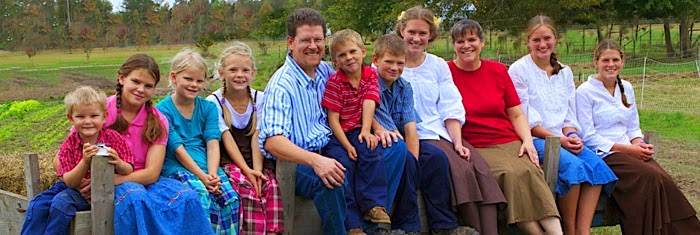Full Quiver Farm in Hampton Roads

Next stop on the New Chesapeake Kitchen tour was to Suffolk, Virginia to Full Quiver Farm where Bonnie North and I met farmers Scott and Alison Wilson. The Wilsons are part of a new breed of Chesapeake farmers. They did not inherit the farm from a long line of ancestral farmers, or spend their formative years in 4-H, but rather, had very successful careers in the high-tech world, he as a web designer and she as a graphic artist, skills that have been instrumental in their farm business, but more about that later.
The Wilsons were leading very busy lives in the world of business while at the same time starting a family of their own. As their first four children were growing up Scott & Alison were constantly concerned with the various health (or maybe un-health) conditions the kids were experiencing, from persistent earaches to asthma.
As they read and learned more about how our (industrial) food was grown and raised all the signs pointed to food as an integral part in their children’s illnesses. What’s a high-tech couple to do? Well, Scott & Alison made a series of life-altering decisions that resulted the now well-known and very successful Full Quiver Farm.
In doing so they laid out a vision and clearly defined their goals:
- Begin to build a family business where all children from the young to the old can be involved in real, meaningful work. Give children more access to the outdoors and large open spaces for plenty of exercise, fresh air, and sunshine.
- Eat healthier and more responsibly by growing most of our own food. Raise our own vegetables and meat in a natural and environmentally friendly way.
- Provide fresh meat and vegetables to health conscious consumers, who are looking for a locally and naturally grown alternative to the conventional fair found at the grocery store.
In 2003 they moved out of the suburbs to a ranch home on 25 acres in Suffolk, Virginia and started trying their hands at raising free-range poultry according to Joel Salatin’s methods. Utilizing the skills they brought with them Alison and Scott were well poised to launch a sound marketing plan. Alison created attractive, professional brochures and offered to give free talks at local libraries educating folks on the importance of healthier eating and “re-learning how to cook.” She promotes utilizing what we often think of as “low end cuts” of meats by crock pot and slow-cooking methods that bring the highest nutrition for the price point: “If you want to eat organic and healthy you will need to see that chicken a little differently.”
Their farming philosophy focuses upon several key points:
- Grown locally with integrity, not diesel trucked halfway across the country
- Eat fresh green pasture, nothing green grows in a metal building
- Fresh feed, ground and mixed locally, not old stale feed that sits and becomes rancid
- Grown outdoors in the sunshine, not in big metal buildings where tons of manure reeks with ammonia fumes… unhealthy
- You get to talk to and have a relationship with the farmer/steward that produces your food… Not just have blind faith that the stuff in the cellophane package in the supermarket is OK to eat
- Our farm enhances the environment. Compost and manure nourishes our pastures and gardens to help grow organic vegetables. We don’t stink up the air and pollute the water with giant manure lagoons
- Our farm enhances people, providing a means to raise healthy, faithful and responsible children for our next generation
- We firmly believe that our health depends on the health and quality of life of the food we eat.
Healthy, happy animals = healthy happy humans!
Within 2 years the Wilsons had added dairy and beef cattle, and pork. By 2007, a mere 4 years on the farm, the operation had proven so successful that both Scott and Alison left their careers completely behind to devote all their energy and time to Full Quiver and to raising their children to be healthy in both body and spirit.
Full Quiver sells at local farmers’ markets and operates a Buying Club through which customers can pre-order and pick up from a number of locations in the area. They offer beef, which Alison warns usually sells out immediately when they get it back from the butcher, pork, including a variety of homemade sausages, fresh brown eggs, pastured chicken and turkeys.
There are quite a number of folks in our Chesapeake region starting out in small-scale production of produce and animal products, but the Wilson’s had the jump on some of the others due to their backgrounds in the high-tech world. Blending old world, traditional farming techniques with the ability to communicate with their greater community via web-based sales and marketing, have helped make Scott and Alison’s operation so very successful in a relatively short period of time.
From Alison: Here is a recipe from my mother’s mother that was passed down to me and my family enjoys. We make it with our own chickens, homemade chicken broth and homemade butter and milk from our cows.
Many thanks to Bonnie North for her research and help with this blog post.
Until next time!
– John
Mima’s Original Chicken Pie Recipe
Serves 4 to 5
Make a sauce out of the following:
6 tablespoons butter
6 tablespoons flour
1 ¾ cups chicken broth
2/3 cups whole milk
Salt and freshly ground black pepper to taste
2 cups cooked chicken, cut into 1-inch pieces
Preheat oven to 425 degrees F.
In a saucepan, melt the butter. Whisk in the flour and continue cooking over medium heat, whisking constantly, for about 3 minutes. Do not brown the flour.
Off the heat, whisk in the chicken broth and whole milk. Stirring constantly, bring to a boil, and then reduce the heat to a simmer, and continue cooking for about 5 minutes. Season the mixture to taste with salt and pepper. Add the cooked chicken to the pot pie sauce. Set mixture aside to cool while making the crust.
Place the pot-pie filling in a long, buttered casserole and cover with the following crust (no thicker than ¼ inch).
Pot Pie Crust
1 ½ cups flour
2 teaspoons baking powder
¼ teaspoon salt
6 tablespoons butter, cut into small pieces
About a ½ cup of milk
Sift the flour, baking powder and salt together into a mixing bowl. Add the butter and work into the flour with your fingertips or pastry cutter, until incorporated. Stir in the milk, a little at a time, until a soft dough is formed. Do not over work the dough, or you will have a tough crust.
On a floured board, roll out the dough and place it over the filling in the casserole pan. Make a few slits in the crust with a sharp knife to allow steam to escape while baking.
Bake the casserole for 30 to 35, or until crust is nicely browned.

Be the first to comment.